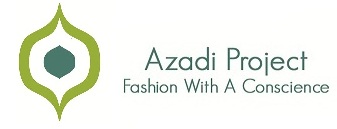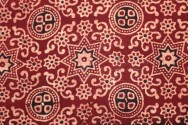Ajrak is the Sindhi word that refers to the distinct block print patterns used to decorate fabrics and tiles in the Sindh region of Pakistan. Ajrak patterns, which are coloured with natural dyes, are typically combinations of white, red, blue, grey, yellow or black. Ajrak is symbolic of the regions artistic heritage and rich cultural past.
History:
Historians and archaeologist have found evidence to suggest that Ajrak is possibly as old as the first human settlements along the Indus River. The cultivation of tree cotton in the region as early as 3000 B.C suggests that fabric construction was already prevalent in this early civilization. The excavation of a carved bust of a king priest who appears to be wearing a block printed shawl, indicates that the art of Ajrak was present as early as 2500 B.C.
Technique:
There are a number of steps involved in creating authentic Ajrak textiles:
- A dye- resistant paste is used on the fabric to prevent the white areas of the pattern from retaining the dyes.
- The hand- carved, block print stamp (tappa) is used to print the borders of the fabric.
- After the border is complete, the interior patterns is stamped using different stamp patterns and/ or variations of the same tappa.
- Ajrak is typically printed on both sides of the fabric. When printing the other side, the tappa must carefully align with the original pattern on the reverse side.
- The fabric is then immersed into the base colour, traditionally red or indigo dye, then washed.
- As new colours are applied, dye resistant paste is re-applied to protect the previously coloured areas.
- This dye and dye-resisting process is repeated numerous times until the desired patterns and colours are achieved.
Ajrak is a precise and time consuming technique that is renowned for it’s history, beauty and design .
Artisans:
The rural artisans of Sindh, create stunning Ajrak textiles using techniques that have been passed down from generations. In fulfilling their objective, AHAN is able provide income opportunities for many disadvantaged Ajrak artisans. The textile are then used for traditional garments such as scarves and shawls, but also used to create more contemporary pieces like bags and clutches.
Our Partnership:
At Azadi Project, we are so privileged to have authentic, hand block printed and naturally dyed, Ajrak in our collection. We take great pride in supporting and promoting an art form as ancient as human history itself. The beauty and popularity of Ajrak has stood the test of time for centuries . We look forward to featuring Ajrak in our collection for years to come.

